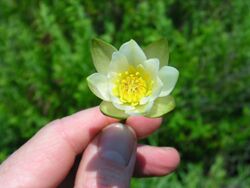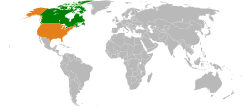Biology:Nymphaea leibergii
| Nymphaea leibergii | |
|---|---|

| |

| |
| Scientific classification | |
| Kingdom: | Plantae |
| Clade: | Tracheophytes |
| Clade: | Angiosperms |
| Order: | Nymphaeales |
| Family: | Nymphaeaceae |
| Genus: | Nymphaea |
| Species: | N. leibergii
|
| Binomial name | |
| Nymphaea leibergii (Morong) Rydb.[3]
| |

| |
| It is native to Canada and Northern USA[3] | |
| Synonyms[3] | |
| |
Nymphaea leibergii, also known as the dwarf waterlily and Leiberg's waterlily, is a perennial emergent aquatic plant belonging to the genus Nymphaea. It can be found across northern North America in ponds and slow moving streams. Populations of this plant are infrequent throughout its range, and it is protected as a state threatened plant in Maine, Michigan, and Minnesota.[4]
Description
This plant is rooted at unbranched rhizomes which give rise to long smooth petioles which terminate in smooth ovate floating leaves. Leaves can be up to 15–19 cm, and have 7-13 radiating veins. The floating flowers are generally typical of waterlilies. They are radially symmetric with prominent yellow stamens and many white petals. The flowers open each day and close again each night.[5]
Taxonomy
Publication
It was first described as Castalia leibergii Morong by Thomas Morong in 1888. Later, it was included in the genus Nymphaea L. published as Nymphaea leibergii (Morong) Rydb. by Per Axel Rydberg in 1932.[3]
Natural hybridisation
It is similar to Nymphaea odorata but much smaller. This species has been found to hybridize with Nymphaea odorata resulting in a sterile hybrid of intermediate morphology.[5][6]
Position within Nymphaea
Nymphaea leibergii is also closely related Nymphaea tetragona, these two species of "small" waterlilies where once thought to be the same species.[7] Today they are recognized as a distinct but form section Chamaenyphaea of the subgenera Nymphaea. N. leibergii has an overlapping range with the circumboreal N. tetragona. However, the former is more common in the central and eastern parts of northern North America, while the latter is more common in the northwestern and western sections. There are differences between the species in both the floral and vegetative parts. In the flower receptacle, where the base is elliptic in N. leibergii, the base has angular protrusions and appears tetragonal in N. tetragona. N. leibergii also has fewer petals and stamens, and a yellowish-brown stigma, where the stigma is purple in N. tetragona.[7]
Etymology
The specific epithet leibergii honours the Swedish-American botanist, forester, and plant collector John Bernhard Leiberg (1853-1913),[8] who discovered the plant in the late 1800s.
Ecology
Habitat
Its habitats include ponds, shallow lakes, slow-moving streams, and edges of slow, open water channels through marshes, up to a depth of approximately 2 m (6.6 ft).[2]
References
- ↑ Maiz-Tome, L. 2016. Nymphaea leibergii. The IUCN Red List of Threatened Species 2016: e.T64318915A67730232. https://dx.doi.org/10.2305/IUCN.UK.2016-1.RLTS.T64318915A67730232.en. Accessed on 03 July 2023.
- ↑ 2.0 2.1 "NatureServe Explorer 2.0". https://explorer.natureserve.org/Taxon/ELEMENT_GLOBAL.2.135296/Nymphaea_leibergii.
- ↑ 3.0 3.1 3.2 3.3 "Nymphaea leibergii (Morong) Rydb." (in en). Royal Botanic Gardens, Kew. http://www.plantsoftheworldonline.org/taxon/171190-2. Retrieved 28 June 2023.
- ↑ Nymphaea leibergii USDA PLANTS Database.
- ↑ 5.0 5.1 Nyphaea leibergii Flora of North America Vol. 3
- ↑ Nymphaea leibergii (dwarf water-lily): Go Botany. (n.d.). Native Plant Trust. Retrieved January 25, 2024, from https://gobotany.nativeplanttrust.org/species/nymphaea/leibergii/
- ↑ 7.0 7.1 Nymphaea tetragona and Nymphaea leibergii (Nymphaeaceae): two species of diminutive water-lilies in North America J.H. Wiersema. 1996. Brittonia. Volume 48, Number 4 / October, 1996
- ↑ WoS. (2022, January 20). Sedum leibergii (Leiberg Stonecrop). World of Succulents. Retrieved January 25, 2024, from https://worldofsucculents.com/sedum-leibergii-leiberg-stonecrop/
Wikidata ☰ Q7071187 entry
 |


